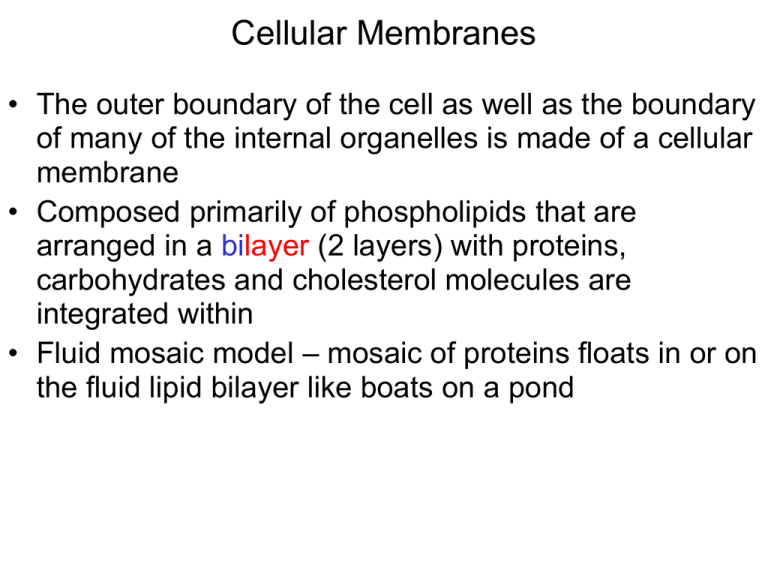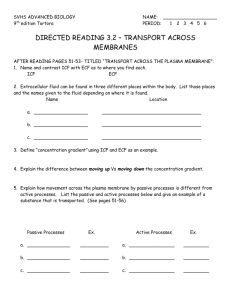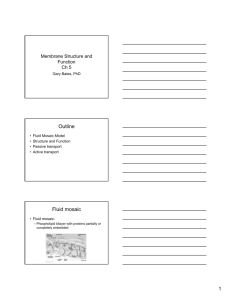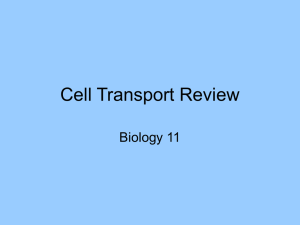Cellular Membranes
advertisement

Cellular Membranes • The outer boundary of the cell as well as the boundary of many of the internal organelles is made of a cellular membrane • Composed primarily of phospholipids that are arranged in a bilayer (2 layers) with proteins, carbohydrates and cholesterol molecules are integrated within • Fluid mosaic model – mosaic of proteins floats in or on the fluid lipid bilayer like boats on a pond 4 Components of Cellular Membranes 1. Phospholipid bilayer • Flexible matrix, barrier to permeability 2. Transmembrane proteins • Integral membrane proteins 3. Interior protein network • Peripheral or Intracellular membrane proteins 4. Cell surface markers • Glycoproteins and glycolipids Phospholipid Models Phospholipids • Structure consists of – Glycerol – a 3-carbon polyalcohol – 2 fatty acids attached to the glycerol • Nonpolar and hydrophobic (“water-fearing”) – Phosphate group attached to the glycerol • Polar and hydrophilic (“water-loving”) • Spontaneously forms a bilayer – Fatty acids are on the inside – Phosphate groups are on both surfaces Plasma Membrane Structure • Bilayers are fluid • Hydrogen bonding of water holds the 2 layers together • Individual phospholipids and unanchored proteins can move through the membrane • Environmental influences on fluidity – Saturated fatty acids make the membrane less fluid than unsaturated fatty acids • “Kinks” introduced by the double bonds keep them from packing tightly • Most membranes also contain sterols such as cholesterol, which can either increase or decrease membrane fluidity, depending on the temperature – Warm temperatures make the membrane more fluid than cold temperatures Plasma Membrane Function • At the surface of a cell, the plasma membrane separates the intracellular fluid (ICF or cytosol) from the extracellular fluid (ECF) of a cell • Provides a means to communicate with other cells • Provides a gateway for exchange between the ECF and ICF – the arrangement of phospholipids in a bilayer makes most of the thickness of the membrane NON-POLAR and thus creates an extremely effective barrier against the movement of polar substances into or out of the cell – membrane proteins determine what gets or stays in/out of a cell which allows the composition of the ICF to be optimal for cellular functions control the movement of substances into/out of the cell Cell Membrane Proteins • Integral or transmembrane proteins – completely pass through the bilayer • extracellular portion is exposed to the ECF –composed of polar amino acids • intracellular portion is exposed to the ICF –composed of polar amino acids • “connect” the ICF and ECF –composed of nonpolar amino acids – different classes of integral proteins are based on function • Peripheral membrane protein – associated only with the intracellular surface of the cell membrane (located in the ICF) – capable of detaching and moving into the cytosol to interact with other molecules within the cell Membrane Proteins • Various functions: 1. Transporters 2. Enzymes 3. Cell-surface receptors 4. Cell-surface identity markers 5. Cell-to-cell adhesion proteins 6. Attachments to the cytoskeleton Integral Membrane Protein Structure Membrane Carbohydrates • The small polysaccharides that are part of the plasma membrane are always immersed in the ECF – covalently bound to an integral membrane protein or a phospholipid head • 2 varieties – Glycolipids • polysaccharides are covalently bound to the polar head of a phospholipid – Glycoproteins • polysaccharides are covalently bound the extracellular portion of an integral membrane protein Modes of Membrane Transport • Transmembrane Transport – movement of small substances through a cellular membrane (plasma, ER, mitochondrial..) • ions, fatty acids, H2O, monosaccharides, steroids, amino acids… – polar substances use integral membrane proteins – nonpolar substances pass directly through the phospholipid bilayer • Vesicular Transport – transport of substances that are TOO LARGE to move through a membrane • proteins, cellular debris, bacteria, viruses… – use vesicles to move substances into/out of the cell Vesicles • “Bubbles” of phospholipid bilayer membrane with substances inside • Created by the “pinching” or “budding” of the phospholipid bilayer membrane – reduces the amount of membrane at that location • Can “fuse” (merge) with another phospholipid bilayer membrane within the cell – adds to the amount of membrane at that location Vesicular Transport • Exocytosis – moves substance out of the cell – fusion of a vesicle with substances with the cell membrane • Endocytosis – moves substances into the cell – cell membrane creates pseudopods (“false feet”) which traps substances in the ECF within a vesicle Types of Endocytosis • Phagocytosis – “cell eating” – endocytosis of few very large substances (bacteria, viruses, cell fragments) – vesicles containing cells fuse with lysosomes which digest the cells • Pinocytosis – “cell sipping” – endocytosis of extracellular fluid • Receptor-mediated endocytosis – endocytosis of a specific substance within the ECF – requires that the substance attaches to the extracellular portion of an integral membrane receptor protein Endocytosis Solutions • The ICF and the ECF are homogeneous mixtures of substances including water, ions, amino acids, disaccharides, triglycerides… called solutions • Solutions are divided into 2 parts – Solvent • substance present in greatest amount • the solvent of the body is water – Solute(s) • substance(s) present in lesser amounts • every other substance in the body is a solute –ions, carbohydrates, proteins, fats, nucleotides… • Solutions are described in terms of their concentration – the amount of solutes in a given volume of solution • Units include: molarity, %, weight per volume ECF vs. ICF • The total solute concentration of the ECF = ICF • The concentration of each solute in the ECF is different from its concentration in the ICF – the cell membrane transports each solute between the ICF and ECF creating gradients for each solute to maintain optimal conditions within the ICF INTRACELLULAR EXTRACELLULAR Major cations: Na + K + Mg ++ Major anions: Cl - HCO 3 Protein Phosphates SO -4 Org. acids 150 100 50 Concentration (mM) 0 0 50 100 Concentration (mM) 150 Concentration Gradients • The difference in the amount of a substance between 2 locations – area of greater amount vs. area of lesser amount – the difference may be LARGE or small – may exist across a physical barrier (membrane) or across a distance without a barrier • Substances in an area of high concentration naturally move toward regions of lower concentrations – Form of mechanical energy where location of greater amount provides more collisions • collisions cause substances to spread out Concentration Gradients Movement of Substances Relative to Gradients Active Transport • The movement of a substance from a region of lesser amount to a region of greater amount is called active transport – moves a substance UP or AGAINST a concentration gradient and requires an energy source – since this movement subtracts from the area of lower concentration and adds to the area of higher concentration it creates a larger difference between the 2 areas causing the gradient to increase Movement of Substances Relative to Gradients Passive Transport • The movement of a substance from a region of greater amount to a region of lesser amount is called passive transport – moves a substance DOWN or WITH a concentration gradient and does NOT require an energy source – actually releases the (same amount of) energy required to create the gradient – causes the gradient to decrease since this movement subtracts from the area of higher concentration and adds to the area of lower concentration creating a smaller difference between the 2 areas Transmembrane Concentration Gradients Equilibrium • Equilibrium – a condition that is met when substances move passively down a gradient until there is equal concentrations of a substance between 2 locations (NO gradient) • no net movement of substances from one location to another –substances continue to move due to heat energy, but movement occurs equally in both directions – Equilibrium of substances across the various membranes in the cells of the body = DEATH • your body is in a constant battle to ensure equilibrium of solutes across the membranes is never reached Transmembrane Concentration Gradients Steady State • Steady State – a condition that is met when substances move passively down a gradient, but then are moved actively back up the gradient – the gradient of a substance is MAINTAINED by the constant expenditure of energy by the cell fighting against equilibrium • no net movement of substances from one location to another –one substance moving passively down the gradient, is exactly balanced by one substance moving actively up the gradient – Life depends upon the ability of the organism to exist in a steady state Transmembrane Transport of Nonpolar vs. Polar Substances • Nonpolar substances cross a membrane through the phospholipid bilayer – ineffective barrier against the movement of nonpolar molecules across a membrane • it is impossible to control the movement of nonpolar molecules through a membrane • Polar substances cross a membrane by moving through integral membrane transporting proteins – Carriers or Channels – Each carrier and channel has a unique tertiary shape and therefore is designed to transport a different substance across a membrane • the cell can control the movement of polar molecules through a membrane by controlling the activity of the transporting proteins Channels • Integral membrane proteins containing a water filled hole (pore) which allows the movement of very small polar substances (ions and water) – passively transport polar substances very quickly across membrane down their respective concentration gradient – some channels have “gates” which can be: • open –allows substance to cross • closed –does not allow substance to cross – channels that do not have gates are always open and are considered to be “leaky” channels Carriers • Integral membrane proteins that “carry” 1 or more small polar substances (monosaccharides, amino acids, nucleotides…) • The movement of only one substance across a membrane is called uniport • The movement of more than one substance across a membrane is called cotransport • change their shape between 2 conformations – “flip-flop” between being open to the ECF and ICF – transport substances much more slowly across a membrane compared to channels • the maximum rate at which these proteins can transport substances across a membrane is limited by how fast they can change shapes Patterns of Transport by Carriers • Symport – 2 substances are moved in the same direction • Antiport – 2 substances are moved in opposite directions • Some carriers passively transport substances down their respective concentration gradient • Other carriers actively transport substances up their respective concentration gradient – carriers called pumps hydrolyze a molecule of ATP and use the energy to pump substances across the membrane against the gradient • Still other carriers simultaneously transport at least one substance up its concentration gradient and one substance down its concentration gradient Passive Transmembrane Transport • Movement a substance to move DOWN its gradient • Releases energy as a result of the movement • Nonpolar substances diffuse through the nonpolar phospholipid bilayer in a process called simple diffusion • Polar molecules require the help (facilitation) of integral membrane proteins (channels or carriers) to cross the bilayer in a process called facilitated diffusion • Diffusion does not occur if there is no gradient – equilibrium Facilitated Diffusion Factors Affecting the Rate of Diffusion • The rate at which a substance moves by way of diffusion is influenced by 3 main factors – Concentration gradient • a large concentration gradient, results in a high rate of diffusion – Temperature • a high temperature, results in a high rate of diffusion –heat causes motion – Size of the substance • a large substance, has a low rate of diffusion –larger objects move more slowly Osmosis • The diffusion of water (solvent) across a selectively permeable membrane is called osmosis – requires “water channels” called aquaporins • Solutes generate a force (osmotic pressure) that “pulls” water molecules toward the solutes – the greater the osmotic pressure, the greater the amount of water movement Tonicity • The difference in the total solute concentration of the ECF vs. the ICF determines the direction and extent of osmosis across the plasma membrane • If the total solute concentration of the ECF = ICF, then the ECF is considered an isotonic (same) solution – water does not move into or out of cell causing no change in the cell volume • If the total solute concentration of the ECF > ICF, then the ECF is considered a hypertonic (more) solution – water diffuses out of the cell causing the cell to shrink (crenate) • If the total solute concentration of the ECF < ICF, then the ECF is considered a hypotonic (less) solution – water diffuses into the cell causing the cell to swell Osmosis and Cell Volume Changes Primary Active Transport • Integral membrane pumps use the energy stored in a molecule of ATP to transport substances across a membrane UP a concentration gradient – The pump: • hydrolyzes the high energy bond in a molecule of ATP (releasing energy) • uses the energy of ATP hydrolysis to “flip-flop” between conformations while moving substances UP a concentration gradient • This process converts chemical energy (ATP) to mechanical energy (gradient across the membrane) – the gradient can be used if necessary by the cell as a form of energy to do work Sodium, Potassium ATPase • Na+,K+-ATPase (Na+,K+ pump) – located in the plasma membrane – actively cotransports: • 3 Na+ from the ICF (lesser amount) to the ECF (greater amount) • 2 K+ from the ECF (lesser amount) to the ICF (greater amount) Secondary Active Transport • Integral membrane carriers move at least 2 different substances across a membrane – One substance moves across a membrane UP a concentration gradient – One substance moves across a membrane DOWN a concentration gradient – The movements of the substance DOWN a concentration gradient releases energy which the carrier uses to “flip-flop” between conformations and move a second substance UP a concentration gradient • “piggyback” transport • This type of transport is called secondary because this process is driven by a gradient that is created by a previous occurring primary active transport process Secondary Active Transport Na+, Glucose Cotransporter






